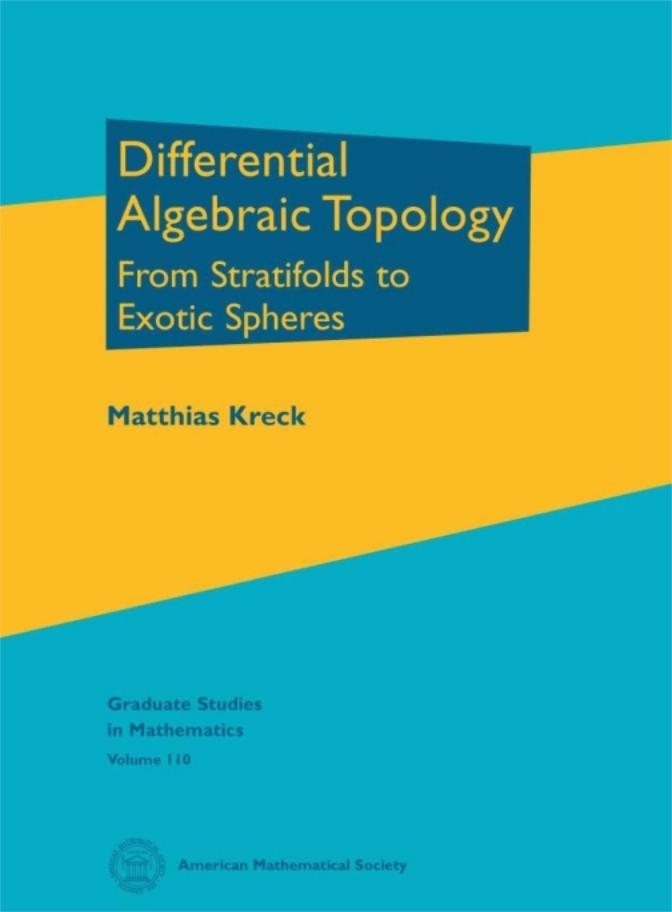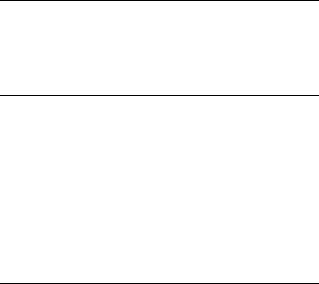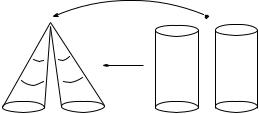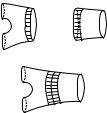
- •INTRODUCTION
- •§1. A word about structures
- •§3. Smooth manifolds revisited
- •§4. Exercises
- •§1. Stratifolds
- •§2. Local retractions
- •§3. Examples
- •§4. Properties of smooth maps
- •§5. Consequences of Sard’s Theorem
- •§6. Exercises
- •§1. Exercises
- •§1. Motivation of homology
- •§2. Z/2-oriented stratifolds
- •§3. Regular stratifolds
- •§4. Z/2-homology
- •§5. Exercises
- •§1. The Mayer-Vietoris sequence
- •§2. Reduced homology groups and homology groups of spheres
- •§3. Exercises
- •§2. A separation theorem
- •§3. Invariance of dimension
- •§4. Exercises
- •§1. The fundamental class
- •§2. Z/2-homology of projective spaces
- •§3. Betti numbers and the Euler characteristic
- •§4. Exercises
- •§1. Integral homology groups
- •§2. The degree
- •§3. Integral homology groups of projective spaces
- •§4. A comparison between integral and Z/2-homology
- •§5. Exercises
- •§1. The axioms of a homology theory
- •§2. Comparison of homology theories
- •§4. Exercises
- •§1. The cross product
- •§3. Exercises
- •§1. Lens spaces
- •§2. Milnor’s 7-dimensional manifolds
- •§3. Exercises
- •§1. Cohomology groups
- •§3. The Mayer-Vietoris sequence
- •§4. Exercises
- •§1. Transversality for stratifolds
- •§2. The induced maps
- •§3. The cohomology axioms
- •§4. Exercises
- •§2. The cup product
- •§3. The Kronecker pairing
- •§4. Exercises
- •§1. Exercises
- •§1. The Euler class
- •§2. Euler classes of some bundles
- •§3. The top Stiefel-Whitney class
- •§4. Exercises
- •§1. Exercises
- •§1. Pontrjagin classes
- •§2. Pontrjagin numbers
- •§3. Applications of Pontrjagin numbers to bordism
- •§5. Exercises
- •§1. The signature theorem and exotic 7-spheres
- •§2. The Milnor spheres are homeomorphic to the 7-sphere
- •§3. Exercises
- •§4. Exercises
- •§1. The product of two stratifolds
- •§2. Gluing along part of the boundary
- •§3. Proof of Proposition 4.1
- •Bibliography
- •Index

Differential Algebraic Topology
From Stratifolds to Exotic Spheres

Differential Algebraic Topology
From Stratifolds to Exotic Spheres
Matthias Kreck
Graduate Studies
in Mathematics
Volume 110
American Mathematical Society
Providence, Rhode Island

EDITORIAL COMMITTEE
David Cox (Chair)
Rafe Mazzeo
Martin Scharlemann
2000 Mathematics Subject Classification. Primary 55–01, 55R40, 57–01, 57R20, 57R55.
For additional information and updates on this book, visit
www.ams.org/bookpages/gsm-110
Library of Congress Cataloging-in-Publication Data
Kreck, Matthias, 1947–
Di erential algebraic topology : from stratifolds to exotic spheres / Matthias Kreck. p. cm. — (Graduate studies in mathematics ; v. 110)
Includes bibliographical references and index. ISBN 978-0-8218-4898-2 (alk. paper)
1. Algebraic topology. 2. Di erential topology. I. Title.
QA612.K7 2010 514 .2—dc22
2009037982
Copying and reprinting. Individual readers of this publication, and nonprofit libraries acting for them, are permitted to make fair use of the material, such as to copy a chapter for use in teaching or research. Permission is granted to quote brief passages from this publication in reviews, provided the customary acknowledgment of the source is given.
Republication, systematic copying, or multiple reproduction of any material in this publication is permitted only under license from the American Mathematical Society. Requests for such permission should be addressed to the Acquisitions Department, American Mathematical Society, 201 Charles Street, Providence, Rhode Island 02904-2294 USA. Requests can also be made by e-mail to reprint-permission@ams.org.
c 2010 by the American Mathematical Society. All rights reserved. The American Mathematical Society retains all rights except those granted to the United States Government.
Printed in the United States of America.
∞ The paper used in this book is acid-free and falls within the guidelines established to ensure permanence and durability.
Visit the AMS home page at http://www.ams.org/
10 9 8 7 6 5 4 3 2 1 |
15 14 13 12 11 10 |

Contents
INTRODUCTION |
ix |
||
Chapter 0. A quick introduction to stratifolds |
1 |
||
Chapter 1. Smooth manifolds revisited |
5 |
||
§1. A word about structures |
5 |
||
§2. |
Di erential spaces |
6 |
|
§3. |
Smooth manifolds revisited |
8 |
|
§4. |
Exercises |
11 |
|
Chapter 2. |
Stratifolds |
15 |
|
§1. |
Stratifolds |
15 |
|
§2. |
Local retractions |
18 |
|
§3. |
Examples |
19 |
|
§4. Properties of smooth maps |
25 |
||
§5. Consequences of Sard’s Theorem |
27 |
||
§6. |
Exercises |
29 |
|
Chapter 3. |
Stratifolds with boundary: c-stratifolds |
33 |
|
§1. |
Exercises |
38 |
|
Chapter 4. |
Z/2-homology |
39 |
|
§1. |
Motivation of homology |
39 |
|
§2. |
Z/2-oriented stratifolds |
41 |
|
§3. |
Regular stratifolds |
43 |
|
§4. |
Z/2-homology |
45 |
|
v
vi |
Contents |
|
|
|
|
§5. |
Exercises |
51 |
Chapter 5. The Mayer-Vietoris sequence and homology groups of |
|
|
|
spheres |
55 |
§1. |
The Mayer-Vietoris sequence |
55 |
§2. Reduced homology groups and homology groups of spheres |
61 |
|
§3. |
Exercises |
64 |
Chapter 6. Brouwer’s fixed point theorem, separation, invariance of |
|
|
|
dimension |
67 |
§1. Brouwer’s fixed point theorem |
67 |
|
§2. |
A separation theorem |
68 |
§3. |
Invariance of dimension |
69 |
§4. |
Exercises |
70 |
Chapter 7. Homology of some important spaces and the Euler |
|
|
|
characteristic |
71 |
§1. |
The fundamental class |
71 |
§2. Z/2-homology of projective spaces |
72 |
|
§3. Betti numbers and the Euler characteristic |
74 |
|
§4. |
Exercises |
77 |
Chapter 8. Integral homology and the mapping degree |
79 |
|
§1. |
Integral homology groups |
79 |
§2. |
The degree |
83 |
§3. Integral homology groups of projective spaces |
86 |
|
§4. A comparison between integral and Z/2-homology |
88 |
|
§5. |
Exercises |
89 |
Chapter 9. A comparison theorem for homology theories and |
|
|
|
CW -complexes |
93 |
§1. The axioms of a homology theory |
93 |
|
§2. |
Comparison of homology theories |
94 |
§3. CW -complexes |
98 |
|
§4. |
Exercises |
99 |
Chapter 10. K¨unneth’s theorem |
103 |
|
§1. |
The cross product |
103 |
§2. |
The K¨unneth theorem |
106 |
§3. |
Exercises |
109 |
Contents |
vii |
|
|
|
|
Chapter 11. Some lens spaces and quaternionic generalizations |
111 |
|
§1. |
Lens spaces |
111 |
§2. |
Milnor’s 7-dimensional manifolds |
115 |
§3. |
Exercises |
117 |
Chapter 12. Cohomology and Poincar´e duality |
119 |
|
§1. |
Cohomology groups |
119 |
§2. |
Poincar´e duality |
121 |
§3. |
The Mayer-Vietoris sequence |
123 |
§4. |
Exercises |
125 |
Chapter 13. Induced maps and the cohomology axioms |
127 |
|
§1. |
Transversality for stratifolds |
127 |
§2. |
The induced maps |
129 |
§3. |
The cohomology axioms |
132 |
§4. |
Exercises |
133 |
Chapter 14. Products in cohomology and the Kronecker pairing |
135 |
|
§1. The cross product and the K¨unneth theorem |
135 |
|
§2. |
The cup product |
137 |
§3. |
The Kronecker pairing |
141 |
§4. |
Exercises |
145 |
Chapter 15. The signature |
147 |
|
§1. |
Exercises |
152 |
Chapter 16. The Euler class |
153 |
|
§1. |
The Euler class |
153 |
§2. Euler classes of some bundles |
155 |
|
§3. |
The top Stiefel-Whitney class |
159 |
§4. |
Exercises |
159 |
Chapter 17. Chern classes and Stiefel-Whitney classes |
161 |
|
§1. |
Exercises |
165 |
Chapter 18. Pontrjagin classes and applications to bordism |
167 |
|
§1. |
Pontrjagin classes |
167 |
§2. |
Pontrjagin numbers |
170 |
§3. Applications of Pontrjagin numbers to bordism |
172 |
|
§4. |
Classification of some Milnor manifolds |
174 |
viii |
|
Contents |
|
|
|
§5. |
Exercises |
175 |
Chapter 19. Exotic 7-spheres |
177 |
|
§1. The signature theorem and exotic 7-spheres |
177 |
|
§2. The Milnor spheres are homeomorphic to the 7-sphere |
181 |
|
§3. |
Exercises |
184 |
Chapter 20. Relation to ordinary singular (co)homology |
185 |
|
§1. SHk(X) is isomorphic to Hk(X; Z) for CW -complexes |
185 |
|
§2. An example where SHk(X) and Hk(X) are di erent |
187 |
|
§3. SHk(M) is isomorphic to ordinary singular cohomology |
188 |
|
§4. |
Exercises |
190 |
Appendix A. Constructions of stratifolds |
191 |
|
§1. The product of two stratifolds |
191 |
|
§2. Gluing along part of the boundary |
192 |
|
§3. Proof of Proposition 4.1 |
194 |
|
Appendix B. The detailed proof of the Mayer-Vietoris sequence |
197 |
|
Appendix C. The tensor product |
209 |
|
Bibliography |
215 |
|
Index |
|
217 |

INTRODUCTION
In this book we present some basic concepts and results from algebraic and di erential topology. We do this in the framework of di erential topology. Homology groups of spaces are one of the central tools of algebraic topology. These are abelian groups associated to topological spaces which measure certain aspects of the complexity of a space.
The idea of homology was originally introduced by Poincar´e in 1895 [Po] where homology classes were represented by certain global geometric objects like closed submanifolds. The way Poincar´e introduced homology in this paper is the model for our approach. Since some basics of di erential topology were not yet far enough developed, certain di culties occurred with Poincar´e’s original approach. Three years later he overcame these di culties by representing homology classes using sums of locally defined objects from combinatorics, in particular singular simplices, instead of global di erential objects. The singular and simplicial approaches to homology have been very successful and up until now most books on algebraic topology follow them and related elaborations or variations.
Poincar´e’s original idea for homology came up again many years later, when in the 1950’s Thom [Th 1] invented and computed the bordism groups of smooth manifolds. Following on from Thom, Conner and Floyd [C-F] introduced singular bordism as a generalized homology theory of spaces in the 1960’s. This homology theory is much more complicated than ordinary homology, since the bordism groups associated to a point are complicated abelian groups, whereas for ordinary homology they are trivial except in degree 0. The easiest way to simplify the bordism groups of a point is to
ix
x |
INTRODUCTION |
|
|
generalize manifolds in an appropriate way, such that in particular the cone over a closed manifold of dimension > 0 is such a generalized manifold. There are several approaches in the literature in this direction but they are at a more advanced level. We hope it is useful to present an approach to ordinary homology which reflects the spirit of Poincar´e’s original idea and is written as an introductory text. For another geometric approach to (co)homology see [B-R-S].
As indicated above, the key for passing from singular bordism to ordinary homology is to introduce generalized manifolds that are a certain kind of stratified space. These are topological spaces S together with a decomposition of S into manifolds of increasing dimension called the strata of S. There are many concepts of stratified spaces (for an important paper see [Th 2]), the most important examples being Whitney stratified spaces. (For a nice tour through the history of stratification theory and an alternative concept of smooth stratified spaces see [Pf].) We will introduce a new class of stratified spaces, which we call stratifolds. Here the decomposition of S into strata will be derived from another structure. We distinguish a certain algebra C of continuous functions which plays the role of smooth functions in the case of a smooth manifold. (For those familiar with the language of sheaves, C is the algebra of global sections of a subsheaf of the sheaf of continuous functions on S.) Others have considered such algebras before (see for example [S-L]), but we impose stronger conditions. More precisely, we use the language of di erential spaces [Si] and impose on this additional conditions. The conditions we impose on the algebra C provide the decomposition of S into its strata, which are smooth manifolds.
It turns out that basic concepts from di erential topology like Sard’s theorem, partitions of unity and transversality generalize to stratifolds and this allows for a definition of homology groups based on stratifolds which we call “stratifold homology”. For many spaces this agrees with the most common and most important homology groups: singular homology groups (see below). It is rather easy and intuitive to derive the basic properties of homology groups in the world of stratifolds. These properties allow computation of homology groups and straightforward constructions of important homology classes like the fundamental class of a closed smooth oriented manifold or, more generally, of a compact stratifold. We also define stratifold cohomology groups (but only for smooth manifolds) by following an idea of Quillen [Q], who gave a geometric construction of cobordism groups, the cohomology theory associated to singular bordism. Again, certain important cohomology classes occur very naturally in this description, in particular the characteristic classes of smooth vector bundles over smooth oriented
INTRODUCTION |
xi |
|
|
manifolds. Another useful aspect of this approach is that one of the most fundamental results, namely Poincar´e duality, is almost a triviality. On the other hand, we do not develop much homological algebra and so related features of homology are not covered: for example the general K¨unneth theorem and the universal coe cient theorem.
From (co)homology groups one can derive important invariants like the Euler characteristic and the signature. These invariants play a significant role in some of the most spectacular results in di erential topology. As a highlight we present Milnor’s exotic 7-spheres (using a result of Thom which we do not prove in this book).
We mentioned above that Poincar´e left his original approach and defined homology in a combinatorial way. It is natural to ask whether the definition of stratifold homology in this book is equivalent to the usual definition of singular homology. Both constructions satisfy the Eilenberg-Steenrod axioms for a homology theory and so, for a large class of spaces including all spaces which are homotopy equivalent to CW -complexes, the theories are equivalent. There is also an axiomatic characterization of cohomology for smooth manifolds which implies that the stratifold cohomology groups of smooth manifolds are equivalent to their singular cohomology groups. We consider these questions in chapter 20. It was a surprise to the author to find out that for more general spaces than those which are homotopy equivalent to CW -complexes, our homology theory is di erent from ordinary singular homology. This di erence occurs already for rather simple spaces like the one-point compactifications of smooth manifolds!
The previous paragraphs indicate what the main themes of this book will be. Readers should be familiar with the basic notions of point set topology and of di erential topology. We would like to stress that one can start reading the book if one only knows the definition of a topological space and some basic examples and methods for creating topological spaces and concepts like Hausdor spaces and compact spaces. From di erential topology one only needs to know the definition of smooth manifolds and some basic examples and concepts like regular values and Sard’s theorem. The author has given introductory courses on algebraic topology which start with the presentation of these prerequisites from point set and di erential topology and then continue with chapter 1 of this book. Additional information like orientation of manifolds and vector bundles, and later on transversality, was explained was explained when it was needed. Thus the book can serve as a basis for a combined introduction to di erential and algebraic topology.
xii |
INTRODUCTION |
|
|
It also allows for a quick presentation of (co)homology in a course about di erential geometry.
As with most mathematical concepts, the concept of stratifolds needs some time to get used to. Some readers might want to see first what stratifolds are good for before they learn the details. For those readers I have collected a few basics about stratifolds in chapter 0. One can jump from there directly to chapter 4, where stratifold homology groups are constructed.
I presented the material in this book in courses at Mainz (around 1998) and Heidelberg Universities. I would like to thank the students and the assistants in these courses for their interest and suggestions for improvements. Thanks to Anna Grinberg for not only drawing the figures but also for careful reading of earlier versions and for several stimulating discussions. Also many thanks to Daniel M¨ullner and Martin Olbermann for their help. Diarmuid Crowley has read the text carefully and helped with the English (everything not appropriate left over falls into the responsibility of the author). Finally Peter Landweber read the final version and suggested improvements with a care I could never imagine. Many thanks to both of them. I had several fruitful discussions with Gerd Laures, Wilhelm Singhof, Stephan Stolz, and Peter Teichner about the fundamental concepts. Theodor Br¨ocker and Don Zagier have read a previous version of the book and suggested numerous improvements. The book was carefully refereed and I obtained from the referees valuable suggestions for improvements. I would like to thank these colleagues for their generous help. Finally, I would like to thank Dorothea Heuk¨aufer and Ursula Jagtiani for the careful typing.

Chapter 0
A quick introduction to stratifolds
In this chapter we say as much as one needs to say about stratifolds in order to proceed directly to chapter 4 where homology with Z/2-coe cients is constructed. We do it in a completely informal way that does not replace the definition of stratifolds. But some readers might want to see what stratifolds are good for before they study their definition and basic properties.
An n-dimensional stratifold S is a topological space S together with a class of distinguished continuous functions f : S → R called smooth functions. Stratifolds are generalizations of smooth manifolds M where the distinguished class of smooth functions are the C∞-functions. The distinguished class of smooth functions on a stratifold S leads to a decomposition of S into disjoint smooth manifolds Si of dimension i where 0 ≤ i ≤ n, the dimension of S. We call the Si the strata of S. An n-dimensional stratifold is a smooth manifold if and only if Si = for i < n.
To obtain a feeling for stratifolds we consider an important example. Let M be a smooth n-dimensional manifold. Then we consider the open cone over M
◦
CM := M × [0, 1)/M×{0},
i.e., we consider the half open cylinder over M and collapse M × {0} to a point.
1

2 |
0. A quick introduction to stratifolds |
◦
Now, we make CM an (n + 1)-dimensional stratifold by describing its distinguished class of smooth functions. These are the continuous functions
◦
f : CM → R,
such that f|M×(0,1) is a smooth function on the smooth manifold M × (0, 1) and there is an > 0 such that f|M×[0, )/M×{0} is constant. In other words,
◦
the function is locally constant near the cone point M × {0}/M×{0} CM. The strata of this (n + 1)-dimensional stratifold S turn out to be S0 = M × {0}/M×{0}, the cone point, which is a 0-dimensional smooth manifold, Si = for 0 < i < n + 1 and Sn+1 = M × (0, 1).
One can generalize this construction and make the open cone over any
◦
n-dimensional stratifold S an (n + 1)-dimensional stratifold CS. The strata
◦◦
of CS are: (CS)0 = pt, the cone point, and for 1 ≤ i ≤ n + 1 we have
◦
(CS)i = Si−1 × (0, 1), the open cylinder over the (i − 1)-stratum of S.
Stratifolds are defined so that most basic tools from di erential topology for manifolds generalize to stratifolds.
•For each covering of a stratifold S one has a subordinate partition of unity consisting of smooth functions.
•One can define regular values of a smooth function f : S → R and show that if t is a regular value, then f−1(t) is a stratifold of dimension n − 1 where the smooth functions of f−1(t) are simply
the restrictions of the smooth functions of S.
•Sard’s theorem can be applied to show that the regular values of a smooth function S → R are a dense subset of R.
As always, when we define mathematical objects like groups, vector spaces, manifolds, etc., we define the “allowed maps” between these objects, like homomorphisms, linear maps, smooth maps. In the case of stratifolds we do the same and call the “allowed maps” morphisms. A morphism f : S → S is a continuous map f : S → S such that for each smooth
0. A quick introduction to stratifolds |
3 |
function ρ : S → R the composition ρf : S → R is a smooth function on S. It is a nice exercise to show that the morphisms between smooth manifolds are precisely the smooth maps. A bijective map f : S → S is called an isomorphism if f and f−1 are both morphisms. Thus in the case of smooth manifolds an isomorphism is the same as a di eomorphism.
Next we consider stratifolds with boundary. For those who know what an n-dimensional manifold W with boundary is, it is clear that W is a topo-
logical space together with a distinguished closed subspace ∂W W such
◦
that W −∂W =: W is a n-dimensional smooth manifold and ∂W is a (n−1)- dimensional smooth manifold. For our purposes it is enough to imagine the same picture for stratifolds with boundary. An n-dimensional stratifold T
with boundary is a topological space T together with a closed subspace ∂T,
◦
the structure of a n-dimensional stratifold on T = T − ∂T, the structure of an (n − 1)-dimensional stratifold on ∂T and an additional structure (a collar) which we will not describe here. We call a stratifold with boundary a c-stratifold because of this collar.
The most important example of a smooth n-dimensional manifold with boundary is the half open cylinder M × [0, 1) over a (n − 1)-dimensional manifold M, where ∂M = M × {0}. Similarly, if S is a stratifold, then we give S×[0, 1) the structure of a stratifold T with ∂T = S×{0}. In the world of stratifolds the most important example of a c-stratifold is the closed cone over a smooth (n − 1)-dimensional manifold M. This is denoted by
CM := M × [0, 1]/M×{0},
where ∂CM := M ×{1}. More generally, for an (n−1)-dimensional stratifold S one can give the closed cone
CS := S × [0, 1]/S×{0}
the structure of a c-stratifold with ∂CS = S × {1}.
If T and T are stratifolds and f : ∂T → ∂T is an isomorphism one can paste T and T together via f. As a topological space one takes the disjoint union T T and introduces the equivalence relation which identifies x ∂T with f(x) ∂T . There is a canonical way to give this space a stratifold structure. We denote the resulting stratifold by
T f T .
If ∂T = ∂T and f = id, the identity map, we write
T T

4 |
0. A quick introduction to stratifolds |
instead of T f T .
Instead of gluing along the full boundary we can glue along some components of the boundary, as shown below.
If a reader decides to jump from this chapter straight to homology (chapter 4), I recommend that he or she think of stratifolds as mathematical objects very similar to smooth manifolds, keeping in mind that in the world of stratifolds constructions like the cone over a manifold or even a stratifold are possible.
